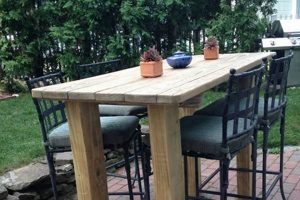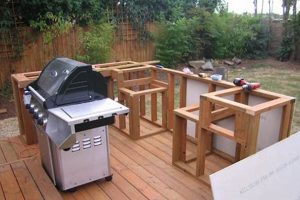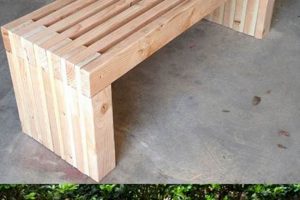A self-constructed protective encasement for external water spigots is designed to mitigate the risk of freezing during periods of low temperature. These custom solutions typically employ readily available materials such as insulation, fabric, or plastic to create a barrier against the elements. As an example, a homeowner might fashion a cover from insulated foam board, securing it around the faucet with duct tape or weather-resistant ties.
The primary importance of these protective measures lies in preventing burst pipes and subsequent water damage, which can be costly to repair. Protecting outdoor fixtures against freezing conditions has been a consideration for property owners in colder climates for many years, with early solutions involving blankets or rags. Modern approaches offer more effective and durable methods for maintaining water systems through winter.
The subsequent sections will elaborate on the selection of appropriate materials, step-by-step construction methods, and alternative design considerations for creating an effective and durable safeguard for exterior water access points.
Essential Considerations for Safeguarding Exterior Water Spigots
This section provides crucial guidance for constructing and implementing effective protective measures for outdoor water spigots against freezing temperatures. Adherence to these recommendations will enhance the lifespan and effectiveness of the protective system.
Tip 1: Material Selection: Employ insulation materials with a high R-value, such as closed-cell foam or fiberglass batting, to maximize thermal resistance. Avoid materials that readily absorb moisture, as this can reduce their insulating capacity.
Tip 2: Secure Attachment: Ensure the protective encasement is firmly affixed to the exterior wall to prevent displacement by wind or other external forces. Utilize weather-resistant tape, straps, or fasteners suitable for outdoor use.
Tip 3: Complete Coverage: The protective covering must completely encapsulate the faucet and any exposed piping immediately adjacent to the wall. Any gaps or openings will compromise the system’s effectiveness.
Tip 4: Weather Resistance: The outer layer of the protective solution should be constructed from a waterproof or water-resistant material to prevent moisture ingress into the insulation. Plastic sheeting, heavy-duty fabric, or specialized weatherproof covers are suitable options.
Tip 5: Regular Inspection: Periodically inspect the protective system throughout the winter months to ensure it remains intact and undamaged. Promptly repair any tears, gaps, or loose connections.
Tip 6: Drainage Consideration: Implement a means of drainage to prevent the accumulation of condensation or melted snow within the protective encasement. This will mitigate the risk of corrosion or ice formation.
Tip 7: Pre-Freeze Preparation: Prior to the onset of freezing temperatures, ensure the exterior faucet is completely shut off and any residual water is drained from the pipes. This minimizes the potential for ice expansion within the plumbing system.
Proper implementation of these guidelines will significantly reduce the risk of frozen pipes and associated damage, thereby preserving the integrity of the plumbing infrastructure throughout the winter season.
The following section will delve into the maintenance strategies for ensuring prolonged efficacy of the constructed protection and strategies for addressing unforeseen issues.
1. Insulation R-value
Insulation R-value is a critical determinant of the effectiveness of any do-it-yourself outdoor faucet cover. This value quantifies the thermal resistance of a material; a higher R-value indicates greater insulating capacity, and consequently, better protection against heat loss.
- Definition and Measurement
R-value represents a material’s ability to resist heat flow. It is typically expressed in units of Ffth/BTU (US customary) or Km/W (SI units). The higher the R-value, the more effective the insulation is at preventing heat from escaping. Standard testing protocols are used to determine the R-value of different materials under controlled laboratory conditions.
- Material Selection Implications
When constructing an outdoor faucet cover, the choice of insulation material directly impacts the degree of protection afforded to the spigot. Materials with low R-values, such as thin fabrics, offer minimal resistance to heat loss and are unsuitable for cold climates. Conversely, materials with high R-values, such as closed-cell spray foam or thick fiberglass batting, provide superior thermal protection.
- Environmental Considerations
The required R-value for an outdoor faucet cover is contingent upon the severity of the local climate. Regions experiencing prolonged sub-freezing temperatures necessitate insulation with a higher R-value compared to areas with milder winters. Local building codes may also specify minimum R-value requirements for plumbing insulation.
- Cost-Benefit Analysis
While materials with higher R-values typically incur a greater initial cost, the long-term benefits of enhanced freeze protection often outweigh the initial investment. Preventing burst pipes and subsequent water damage can result in significant cost savings, making the selection of appropriate insulation a financially prudent decision.
In summary, the R-value of insulation is a fundamental consideration in the design and construction of a effective protective covering for outdoor faucets. Selecting materials with an appropriate R-value, based on climate and local codes, is essential for mitigating the risk of frozen pipes and ensuring the reliable operation of the water system throughout the winter season.
2. Secure Attachment
The method by which a protective encasement is affixed to an exterior water spigot is of paramount importance in ensuring its efficacy throughout periods of inclement weather. A failure in secure attachment can render even the most well-insulated cover ineffective, exposing the faucet to freezing temperatures and potentially resulting in costly damage.
- Wind Resistance and Environmental Factors
Exterior faucet covers are routinely exposed to strong winds, heavy precipitation, and other environmental stressors. A secure attachment system must be capable of withstanding these forces to prevent dislodgement of the cover. Inadequate attachment can lead to the cover being blown away, leaving the faucet vulnerable to freezing.
- Material Compatibility and Longevity
The choice of attachment materials, such as straps, tape, or fasteners, must be compatible with both the cover material and the exterior wall surface. Incompatible materials may degrade over time, compromising the integrity of the attachment. Weather-resistant materials are crucial to ensuring long-term securement.
- Installation Technique and Accessibility
The attachment method should be straightforward to install, allowing for easy application and removal as needed for faucet access. Overly complex or difficult-to-manage attachment systems may discourage proper installation or lead to improper re-attachment after use, negating the protective benefits.
- Preventing Water Intrusion
The attachment system itself should not create pathways for water to enter the insulated area around the faucet. Poorly sealed straps or improperly applied tape can allow moisture to seep into the insulation, reducing its effectiveness and potentially accelerating corrosion of the faucet itself.
In conclusion, the selection and implementation of a robust and appropriately chosen secure attachment mechanism is integral to the success of any self-constructed protective encasement for exterior water spigots. Failure to prioritize secure attachment will compromise the protective function of the cover, increasing the risk of freezing and damage to the plumbing system.
3. Complete Encapsulation
Complete encapsulation is a foundational principle in the effective design and implementation of a self-constructed protective encasement for exterior water spigots. It dictates that the entirety of the faucet and any adjacent exposed plumbing must be fully enclosed within the protective covering to prevent localized freezing.
- Elimination of Thermal Bridges
Thermal bridges, points where heat readily conducts out of a system, can severely compromise the overall effectiveness of an insulation strategy. Complete encapsulation eliminates these bridges by ensuring there are no exposed metallic surfaces in direct contact with the ambient environment. An example of this would be ensuring that no part of the faucet is protruding from the insulating material.
- Mitigation of Convective Heat Loss
Convective heat loss occurs when air currents circulate around a surface, carrying heat away. Complete encapsulation minimizes convective heat loss by creating an enclosed, still-air environment around the faucet. A cover with gaps or openings will allow air to circulate, significantly reducing its insulation value. A real-world example is when a homeowner leaves a small opening at the bottom of the cover, permitting airflow and diminishing effectiveness.
- Prevention of Ice Formation within the Cover
Moisture can accumulate inside the protective covering due to condensation or precipitation. If complete encapsulation is not achieved, this moisture can freeze and expand, potentially damaging the faucet or compromising the insulation material. Ensuring a tight seal prevents moisture ingress and subsequent ice formation. For instance, improper sealing around the faucet handle could allow water to enter and freeze.
- Uniformity of Protection
Complete encapsulation ensures that all parts of the faucet receive a consistent level of protection. Uneven coverage can lead to localized freezing in areas that are less insulated. As an example, a cover that is thick on the top but thin on the bottom may result in the bottom portion of the faucet freezing first.
By achieving complete encapsulation, property owners can significantly reduce the risk of frozen pipes and associated water damage. This principle should be a central consideration in the design, construction, and installation of any protective covering for outdoor faucets. The level of protection afforded directly correlates with the thoroughness of the encapsulation effort.
4. Weather Resistance
Weather resistance is a critical attribute of any self-constructed protective encasement for external water spigots. The ability of a cover to withstand the elements directly impacts its longevity and effectiveness in preventing freeze damage.
- Material Degradation and Longevity
The materials used in a exterior faucet cover must resist degradation from prolonged exposure to sunlight (UV radiation), moisture, temperature fluctuations, and physical abrasion from wind or ice. Degradation compromises the cover’s structural integrity and insulating properties, reducing its ability to protect against freezing. An example is using a plastic sheeting that becomes brittle and cracks after a single season of sun exposure, thus losing its water resistance.
- Moisture Intrusion and Insulation Effectiveness
Weather resistance prevents moisture from penetrating the cover’s outer layers and saturating the insulation. Wet insulation loses its thermal resistance, rendering the cover less effective. Using a breathable, water-resistant fabric as an outer layer can allow moisture to escape while preventing rain or snow from entering. Conversely, a non-breathable, damaged material will trap condensation inside, negating its insulating properties.
- Structural Integrity Under Stress
A weather-resistant cover maintains its structural integrity even when subjected to strong winds, heavy snow loads, or ice accumulation. Weak seams, flimsy materials, or poor design can lead to the cover tearing or collapsing under stress, exposing the faucet to the elements. Reinforcing seams with durable, waterproof tape and using a sturdy frame can enhance structural integrity.
- Prevention of Mold and Mildew Growth
Weather-resistant materials inhibit the growth of mold and mildew, which can degrade the cover over time and pose health risks. Moisture-permeable or non-treated materials are susceptible to mold growth in damp environments. Using antimicrobial-treated fabrics or applying a mold-resistant coating can mitigate this issue.
Therefore, selection of robust materials with high weather resistance is paramount when creating a durable and effective safeguard for external water fixtures. The long-term performance of self-constructed faucet covers directly depends on the ability to withstand the elements and maintain their protective qualities throughout the winter season.
5. Proper drainage
The incorporation of effective drainage mechanisms within a self-constructed protective encasement for outdoor water spigots is not merely an ancillary consideration, but rather a fundamental component directly influencing the system’s overall performance and longevity. Without adequate provisions for drainage, moisture accumulation within the cover can negate the benefits of insulation and potentially exacerbate freeze-thaw cycles, leading to fixture damage. Condensation, rainwater intrusion, or melted snow can become trapped, creating an environment conducive to ice formation. As water freezes, it expands, exerting significant pressure on the faucet and adjacent piping, increasing the risk of cracks or bursts. Proper drainage mitigates this risk by providing a pathway for accumulated moisture to escape, thereby maintaining a dry and functional environment around the faucet.
Consider, for example, a scenario where a homeowner diligently constructs an insulated faucet cover using high-quality materials and secures it effectively to the exterior wall. However, the design fails to account for drainage. Over the course of the winter, condensation forms inside the cover due to temperature differentials. Without an outlet, this moisture accumulates and eventually freezes. The resulting ice mass presses against the faucet valve, causing it to crack. Upon thawing, the damaged valve leaks, resulting in significant water waste and property damage. In contrast, a cover incorporating a simple drainage hole at its base would allow this condensation to escape, preventing the freeze-thaw cycle and preserving the integrity of the faucet.
In conclusion, designing for effective drainage is not optional but imperative when constructing a protective covering for outdoor spigots. Addressing moisture accumulation through strategic drainage implementation safeguards the plumbing system from the damaging effects of freezing temperatures. The absence of proper drainage mechanisms introduces an avoidable vulnerability that compromises the protective function and operational lifespan of the entire system. Failing to include it negates other good design efforts.
Frequently Asked Questions
This section addresses common inquiries regarding self-constructed protective measures for outdoor water faucets, providing clarity on crucial aspects of design, implementation, and maintenance.
Question 1: What constitutes an adequate R-value for insulation in a cold climate?
The necessary R-value is contingent upon the specific climate zone. Regions experiencing sustained sub-freezing temperatures necessitate higher R-values, typically ranging from R-13 to R-30, for effective protection. Local building codes often stipulate minimum R-value requirements for plumbing insulation.
Question 2: How does moisture impact the effectiveness of a protective covering?
Moisture significantly reduces the insulating capacity of most materials. Wet insulation conducts heat more readily than dry insulation, diminishing the protective effect and increasing the risk of freezing. Weather-resistant outer layers and proper drainage mechanisms are crucial for mitigating moisture-related performance degradation.
Question 3: Is it necessary to turn off the water supply to the exterior faucet before installing the cover?
Closing the water supply valve and draining any residual water from the faucet and connected piping is highly recommended. This action reduces the volume of water susceptible to freezing and expansion, thereby minimizing the risk of burst pipes. Neglecting this step can compromise the effectiveness of the protective cover.
Question 4: What type of material is most suitable for the outer layer of the protective cover?
A durable, weather-resistant material such as heavy-duty canvas, waterproof nylon, or reinforced polyethylene sheeting is optimal. The outer layer should effectively repel water, resist UV degradation, and withstand physical abrasion from wind and ice. Materials that readily absorb moisture or degrade under sunlight are unsuitable.
Question 5: How often should the protective cover be inspected during the winter season?
Regular inspections, ideally on a monthly basis or following significant weather events (e.g., heavy snowfall, high winds), are essential to ensure the cover remains intact and securely fastened. Promptly repair any tears, gaps, or loose connections to maintain optimal protection.
Question 6: Can commercially available faucet covers be as effective as self-constructed solutions?
Commercially available covers can provide adequate protection if properly sized and installed. However, self-constructed solutions offer the advantage of customization, allowing for precise fit and the incorporation of specific insulation materials and drainage features tailored to individual needs and environmental conditions. Inspecting the R-value is important.
Adhering to these principles can markedly decrease the likelihood of freeze-related plumbing damage and enhance the resilience of outdoor water systems during winter conditions.
The subsequent section will explore innovative and cost-effective protection methods for uniquely positioned or exceptionally vulnerable exterior water spigots.
Concluding Remarks on Exterior Faucet Protection
The preceding discussion has explored critical facets of constructing a “diy outdoor faucet cover” system to safeguard plumbing infrastructure during periods of sub-freezing temperatures. Key elements, including insulation R-value, secure attachment, complete encapsulation, weather resistance, and proper drainage, have been delineated as essential for optimal performance. The importance of appropriate material selection, rigorous installation techniques, and ongoing maintenance procedures has been underscored to ensure enduring effectiveness of self-constructed solutions.
The diligent application of the principles outlined herein offers a proactive approach to mitigating the risks associated with frozen pipes and the resultant property damage. Implementing a carefully considered and well-executed protective strategy represents a prudent investment in the long-term integrity and functionality of residential and commercial plumbing systems. Prudent measures in protecting water systems remains an important considerations for property management.


![Build Your Own DIY Wood Rack Outdoor [Easy Guide] The DIY Hub: Creative Crafts, Repairs & Life Hacks Build Your Own DIY Wood Rack Outdoor [Easy Guide] | The DIY Hub: Creative Crafts, Repairs & Life Hacks](https://craftingdiycenter.com/wp-content/uploads/2025/07/th-2656-300x200.jpg)




